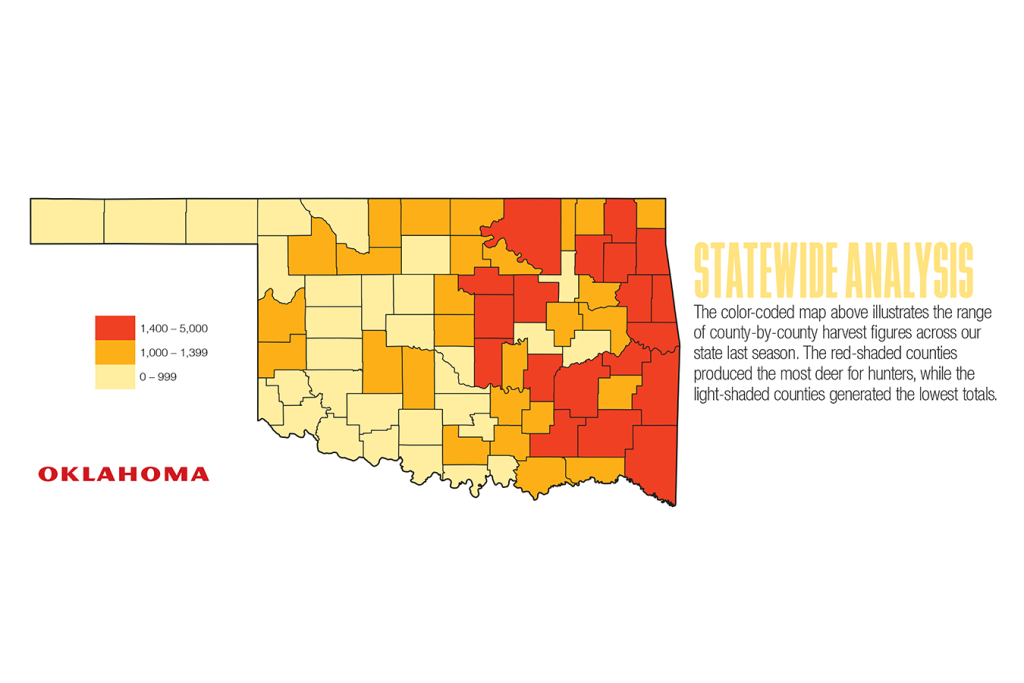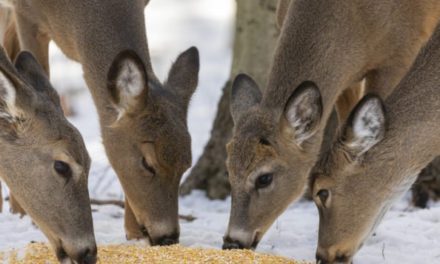
Photo By Ron Sinfelt
Thank goodness for rain.
For several years recently we saw a decline in populations of many kinds of Oklahoma wildlife as drought persisted year after year, especially in the western parts of our state.
As the drought persisted, many hunters and landowners were seeing far fewer deer than usual.
Thank goodness, after a couple of years of more normal rainfall, we’re seeing a rebound in several species. Last year’s deer harvest was a marked improvement over the previous year’s kill.
Oklahoma hunters in all three seasons — gun, muzzleloader and archery — checked in 99,023 deer. That’s a healthy jump from the 88,467 harvested during the 2015 seasons.
It’s even a little better than the 2014 harvest of 97,275, but still quite a bit below the peak harvest of 119,349 deer taken in 2006.
Dr. James Kroll and Pat Hogan discuss the impact of wind on deer behavior.
(Via North American Whitetail)
Those are the official figures, based on deer that hunters reported to the Wildlife Department. You can bet the harvest was at least a little higher because of unreported deer.
So I’m betting we killed easily more than 100,000 deer during the 2016 seasons, although the official tally remains 99,023.
Where were those deer taken?
As happens nearly every year, the same few counties make up most of the Top 10 harvest list. In some cases, like Osage County, for example, the harvest is large because the county is large, even though the deer killed per square mile is lower than in some smaller counties. Osage County, which has a lot of good deer habitat, is also about 2 1/2 times the average size of Oklahoma’s 77 counties (2,304 square miles compared to an average of 908 square miles.)
Jerry Shaw, programs supervisor in the Wildlife Division of the Oklahoma Department of Wildlife Conservation, oversees the data collection and analysis for deer herd management statewide. He and his staff tally the harvests and keep watch over habitat changes, herd growth or decline, and look for other factors that might affect deer numbers and hunting success.
I asked Shaw a few questions about Oklahoma’s deer and about our recent harvest trends.
Question: Do you think the prolonged drought that we had up until a couple of years ago had a significant impact on deer numbers?
Shaw: “Definitely. Our area managers, the game wardens, landowners and hunters, especially out west where the drought was most severe, saw fawns abandoned because does couldn’t feed them. Cover was really scarce in places, which probably allowed predators, like coyotes, to capture more fawns.
“We don’t have hard data on the effects of the drought, but the consensus is that the drought was a big factor. Prior to that, we were in a longer-than-usual period with above-average rainfall. Those were the years when our harvests were up there approaching 120,000 deer.
“Our harvests definitely reflect wet and dry weather cycles,” Shaw said.
Q: We killed more trophy bucks last year than in any recent year that I know of. What do you think was the biggest factor?
Shaw: “Honestly, I think the biggest factor is a change in the mindset of hunters. I think we have more hunters now who are willing to pass on younger bucks and give them a chance to grow a good rack.”
Q: A few years back we lowered the buck limit from three to two. Do you think that was an important factor in producing more big bucks?
Shaw: “Well, I don’t think it was a huge factor. For one thing, it’s a very small percentage of hunters who actually take their limit of bucks. I still think the fact that more hunters are letting the bucks get a little older is probably the main reason.
Q: Are deer hunters increasing? Decreasing? Or are the numbers pretty stable in Oklahoma?
Shaw: “It’s all three. Gun hunter numbers are pretty stable. It goes up and down slightly from year to year, but it’s the most stable of the three.
“Muzzleloader hunters have declined quite a bit. They still kill a good number of deer, but their numbers have declined, not grown, in the past few seasons.
“Archery is the big story. Bowhunters have increased tremendously. Even the National Bowhunting Equipment Manufacturers’ trade organization has asked us what we’re doing because so many people have taken up bowhunting here.”
Q: A few seasons back we liberalized regulations to allow all bowhunters, instead of just older hunters or those with physical limitations, to use crossbows. Was that a big factor in the growth of bowhunting?
Shaw: “Well, I can’t say for sure it didn’t have an effect, but we were seeing big growth in bowhunter numbers even before we opened it up for crossbow hunting.
“I think it is more because we have a 3 1/2-month archery season, compared to 9 or 16 days for muzzle-loader and gun. It allows hunters to hunt pre-rut, the peak of the rut, and for several more weeks after that.
“I think, too, that some hunters may take deer with a bow that they might be reluctant to take with a muzzleloader or gun.
Q: We know there are always some hunters who fail to check in their deer, even though the deer were taken in season and with proper licenses and tags. Do you think changing over to online reporting, instead of going to physical check stations that may or may not be open when it’s convenient to hunters, has made a difference in reporting trends?
Shaw: “We recognize that not all deer are reported, even when they’re taken legally. We went to online checking to make it easier for hunters to report their kills. But besides the online check-in, we also survey a number of hunters each year about several things, including about whether they checked in their deer or not.
“We didn’t really see any change in the trend after we went to online checking. We know the poachers and out-of-season hunters aren’t checking their deer anyway, but we think the online check-in makes it much easier for most hunters to report what they’ve harvested. (Hunters can go to wildlifedepartment.com to check their deer.)
Q: You say that some hunters are passing up younger bucks and waiting for better deer these days? Are more hunters taking does?
Shaw: “Last year the harvest included 39 percent does. That’s pretty consistent with what we see most years — something in the 40 percent range.”
Q: So we killed 99,023 deer last fall and winter. That’s well below the 119,000 or so that were killed in 2006. Do you think the harvest will increase much? Shrink more?
Shaw: “Well, as I said earlier, the wet and dry weather cycles are a big part of the equation. We think the ‘sweet spot’ is just about what we had last year; about 100,000. We know that the harvest will vary, depending on many factors, from year to year.
“Not every acre of land in Oklahoma is suitable deer habitat, but when we’re killing about that number, we think it shows that the habitat available is supporting a healthy population.”

MULE DEER RECORD BROKEN
White-tailed deer are found in all 77 of Oklahoma’s counties, but in the Oklahoma Panhandle and a few western counties it’s also possible to bag a mule deer.
Hunters typically take up to 200 mule deer per year, and one Oklahoma hunter bagged a new state record non-typical last fall. Ron Jones, from Pryor, hunting on a lease that borders the Oklahoma-New Mexico state line, killed a 19-point mulie with an inside spread of more than 2 feet! It scored 226 4/8, replacing a 13-pointer killed in 1973 that scored 215.
Cimarron County at the western end of the Panhandle always has the biggest number of mule deer checked in. In that High Plains country mule deer typically are found on the flat-open lands, while the whitetails are more likely to be in the canyons, in the Cimarron River valley, and along creeks where there is more timber.
While there are hundreds of whitetails listed on the database of the Wildlife Department’s Cy Curtis trophy deer recognition program, there are only 19 typical and six non-typical mule deer that have met the minimum scores.
The current leader in the typical category is a 2014 archery kill by hunter Chandler Henderson, also in Cimarron County. It was an 11-pointer that scored 191 7/8.
The post 2017 Oklahoma Deer Forecast appeared first on Game & Fish.


















